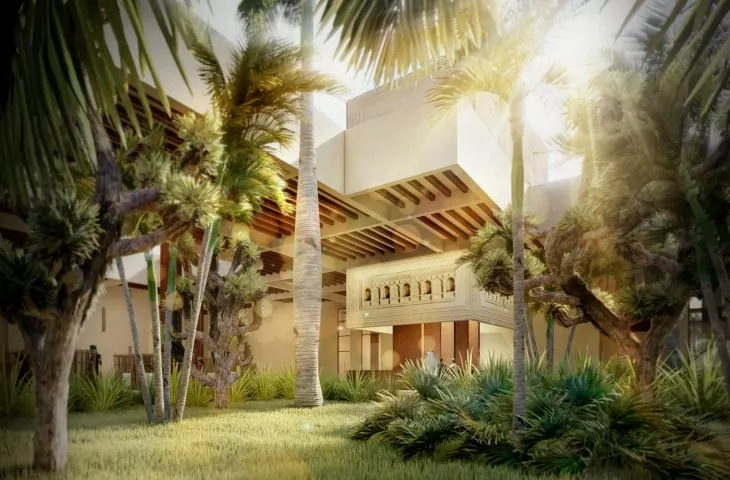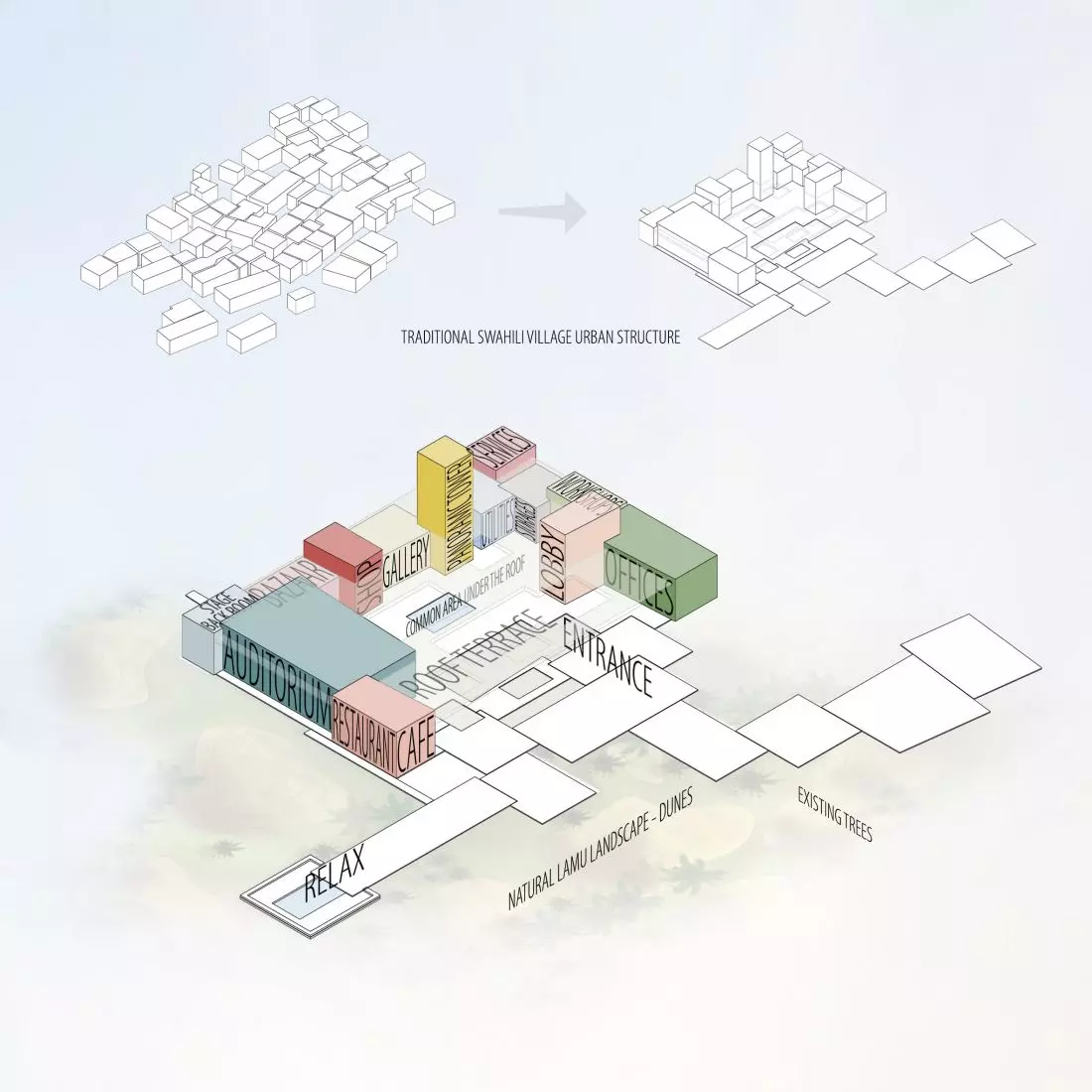Polish architects Konrad Rafacz, Filip Teter, Mariusz Twardowski and Agnieszka Żabicka are the authors of the design of the Swahili Heritage Center, for which they received first prize in the international competition Legacy - Designing a Swahili heritage hub in Lamu. The task was to design an architectural facility to promote the diverse Swahili cultural heritage.
Lamu Island
Lamu, an African island in the Lamu archipelago, is home to the oldest settlement of the Swahili people. Drawing on influences from Chinese, Portuguese, German, Indian and Arab newcomers, Lamu has created a unique culture over the centuries. Its diverse identity can be seen in its language, art, clothing, food and architecture.
It all began in the 14th century, when Arab merchants established a seaport on the island, where ivory, timber and mangroves were traded. The merchants began to settle on the coast, among the local population, which led to the creation of a people and culture known as Swahili. Until the 17th century, the region was dominated by the slave trade, at which time it saw its greatest economic boom. After the struggle for East Africa, in the late 19th century, most countries abolished slavery, and as a result, the trade collapsed.
The competition task was to design an object that promotes Swahili cultural heritage
© Konrad Rafacz, Filip Teter, Mariusz Twardowski, Agnieszka Żabicka
Now the island of Lamu is facing changes that could contribute to its complete transformation. A massive infrastructure project called LAPSSET is being planned. It is a venture that will connect Kenya, Ethiopia and South Sudan via railroads, highways, pipelines and a huge deep-sea port in Lamu. While the project is intended to boost trade and secure Kenya's position as a major trade player in the region, many locals view it with serious concerns. They fear the development could destroy their historic island and their culture....
how to save swahili cultural heritage?
A rich and multi-layered culture is, what distinguishes the island of Lamu. How, in the face of such changes, can its preservation be ensured? The challenge of the Legacy - Designing a Swahili heritage hub in Lamu competition, organized by the UNI platform, was to design an architectural facility that promotes Swahili cultural heritage. The new cultural center should showcase art forms and customs characteristic of the Lamu islanders. When designing the complex, participants were also to take into account the possibility of holding events and annual celebrations. The designed center was to become a new symbol of Lamu Island's culture.
Each function of the center was designed in a separate cube
© Konrad Rafacz, Filip Teter, Mariusz Twardowski, Agnieszka Żabicka
first prize for polish team
The submitted works were evaluated by a two-person jury consisting of: Eoghan Lewis (Eoghan Lewis Architects, Australia) and Puran Kumar (Studio PKA, India). Among the projects was the concept of a team of Polish architects, which received the first prize! The authors of the winning work are: Konrad Rafacz, Filip Teter, Mariusz Twardowski and Agnieszka Żabicka.
The form of the building refers to the surrounding buildings
© Konrad Rafacz, Filip Teter, Mariusz Twardowski, Agnieszka Żabicka
The architects, studying the urban character of the plot designated for the project, found a lot of inspiration in it. They decided not to introduce artificial elements, instead they referred to the surrounding buildings. They also did not forget the history of the Swahili people, traditional ornaments and composition. They also decided that a reference to the buildings shaped by the poorest layers of society would be the fairest and truest by design. The entire premise of the cultural center was enclosed in a common space. However, some architectural elements delicately stand out. The observation tower, reminiscent of the towers of minarets, allows observation of the surroundings and easier understanding of the idea of the proposed building. The plane enclosing the first floor space also becomes the second layer of the project - the roof garden.
The entire premise is built around an inner courtyard with a garden
© Konrad Rafacz, Filip Teter, Mariusz Twardowski, Agnieszka Żabicka
Swahili Heritage Center
The design incorporates the numerous functions included in the competition requirements. The main space is a large, open lobby. It is not only a place leading to more rooms, but also a space where one can meet, talk and relax, as well as admire temporary exhibitions. The lobby space includes a large reception desk, whose size allows it to serve both the building itself and cultural events, conferences, concerts and workshops. The reception area was placed in an undercut block with a cube form. Locating individual functions in individual cubes arranged around the main lobby makes moving around the center more intuitive. Each successive "cube" serves a different purpose, has its own character, appropriate size and shape for the function. One of them housed an art gallery to promote culture and art. Nearby, the authors placed a cube with a souvenir store, publications, textiles, delicatessen and elements telling the story of Swahili culture. The next, consisting of three levels, contains rooms for workshops and seminars.
Outdoor relaxation area with fountain
© Konrad Rafacz, Filip Teter, Mariusz Twardowski, Agnieszka Żabicka
The next architectural forms, located between the workshops and reception area, contain storage, technical and office spaces. Each of these spaces is two-story. The final element near this zone is a viewing tower. On the south side of the building is an auditorium with a stage, and right next to it is a cafe with a mezzanine restaurant. Toilets were placed between the geometric blocks. In each functionally separate block one can find fountains called "drinking fountains", characteristic of this area of Kenya.
Each of the spaces proposed in the project in its own way helps establish social relations. The common space of the main lobby [...] large and varied enough is not only a meeting place, but a place for exhibitions, listening to live music, and opening various cultural events. The large auditorium allows concerts, plays, can turn into a cinema, can host a variety of scientific or business conferences. Located next to it, a two-story restaurant with a café on the mezzanine supports backstage conversations and a pleasant time outside the dates of various events. The designed art gallery space will allow visitors to interact, especially during the numerous vernissages. Workshop rooms located on three levels of another cube will support the development of participants, the authors say.
The program of proposed workshops includes not only learning handicrafts, but also educational meetings for children, as well as psychological activities.
The architects took advantage of the varying heights of the surrounding buildings
© Konrad Rafacz, Filip Teter, Mariusz Twardowski, Agnieszka Żabicka
reference to the city of Lamu
The traditional development pattern of the city of Lamu was reflected in the urban layout of the Center. The irregular urban fabric was transposed into the arrangement of cubes enclosed in the design. The architects also took advantage of the varying heights of the masses of the surrounding buildings. The window openings and colors of the facades are also a reference to the character of the neighborhood. The authors also used the traditional distribution of structural beams and the division into modules of three meters in width. An important value of the Center is the local materials used, reliefs and ornaments on the walls and doors.
The building naturally supports passive ventilation and improves thermal control
© Konrad Rafacz, Filip Teter, Mariusz Twardowski, Agnieszka Żabicka
natural ventilation and thermal control
The form of the Cultural Center, through its simple design and thoughtful arrangement of closed and open spaces, naturally supports passive ventilation and improves thermal control. There are gaps between the cubes to ensure air movement and cross ventilation. The front elevation is designed with wooden sliding doors. Their opening is adjustable and can be adjusted to improve or reduce air flow. An upper terrace occupying about eighty percent of the complex's floor space provides an adequate amount of shade. The openings and windows are designed as small elements to minimize thermal radiation and provide lower temperatures within the complex. Larger glazings are located on the atrium side, under the terrace, and are hidden from direct sunlight. Walls and structural elements are made of wood and brick - materials that improve thermal control and help keep the complex energy efficient.
The main space is a large, open lobby
© Konrad Rafacz, Filip Teter, Mariusz Twardowski, Agnieszka Żabicka
passive and ecological building
The architects, aware that the development site has no direct connection to the city's plumbing system, proposed various solutions to make the complex passive and more ecological. The sanitary sewage system was turned into a biocompost system that controls odors and produces fertilizer. The rainwater collection system can be used to flush toilets, replenish groundwater and care for greenery on the project site. On the roofs of the cubes there is a water supply system with tanks connected to the sewage system. They face north and have been shielded by higher attics for protection and to hide them from the sight of visitors. Also, photovoltaic panels and solar panels have been hidden on the roofs of individual blocks, behind taller attics. They generate electricity and provide hot water for the complex.
TheSwahili Heritage HUB is a study project, but the architects are in contact with Fahim Yasin Twaha Governor of Lamu County and Josphat Musembi head of the Department of Trade, Investment, Local and International Funds andResource Mobilization, Culture and Tourism of Lamu County, regarding the presentation of the project at the Lamu Cultural Festival in November and making further, steps regarding the possible implementation of the Swahili Heritage Center.















































